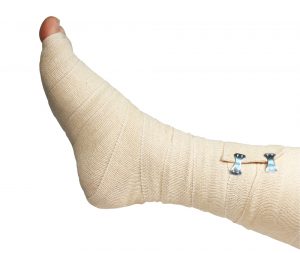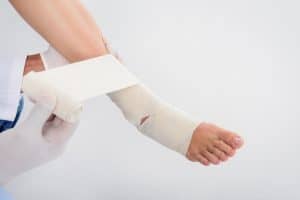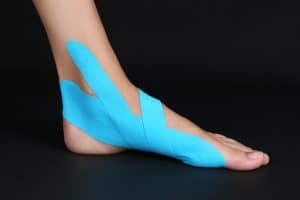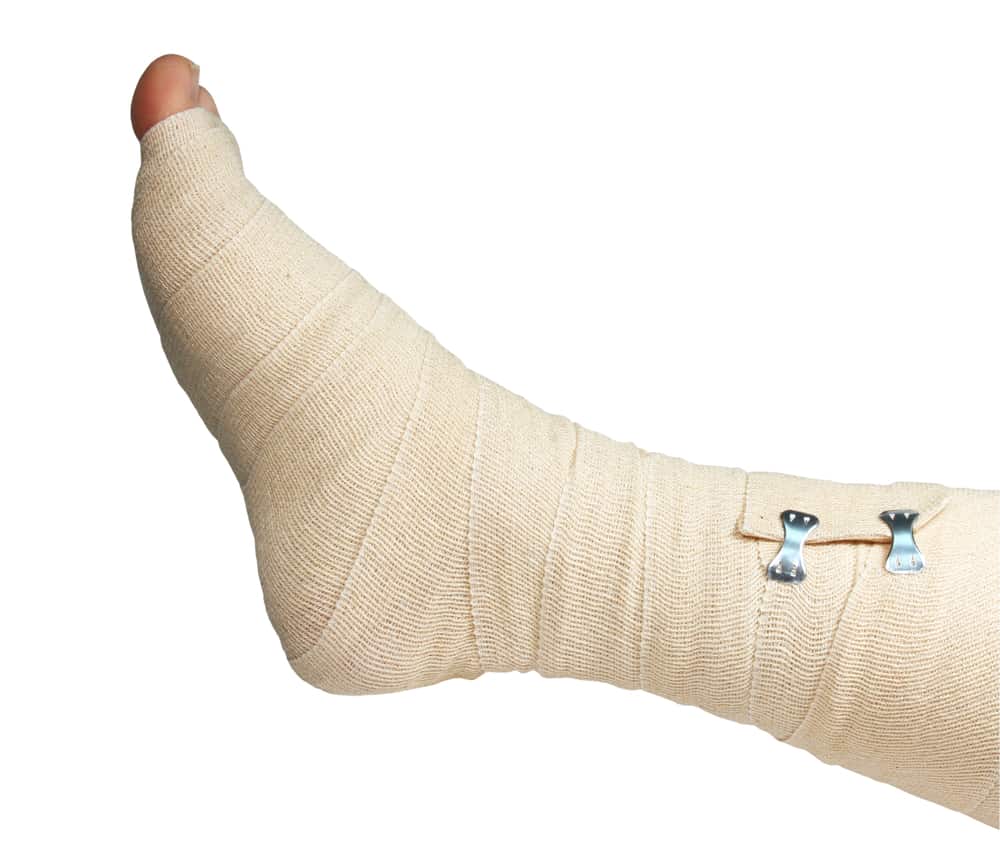How to Wrap Foot for Plantar Fasciitis With Ace Bandage
Plantar fasciitis can be a real pain. You walk around feeling like tiny knives are stabbing at your feet. No, it’s not the best feeling!
Unfortunately, plantar fasciitis is quite common among runners; it’s an overuse injury, and runners are no strangers to overusing their muscles.
To treat this condition, you need to visit a doctor and get a proper diagnosis. The condition can be treated using medications in most cases, but some severe cases require more time than others.
In all cases, using an Ace bandage will help fasten the healing and ease the pain. So here, we’ll teach you how to wrap foot for plantar fasciitis with Ace bandage.

What’s Special About Ace Bandages?
Most people think Ace is a type of bandage, but it’s actually a brand that got so famous that now, all elastic cotton bandages are referred to as Ace bandages.
Ace bandages are elastic and comfortable, and they help with a multitude of injuries because they stabilize the ligaments, preventing unnecessary movements.
These bandages are also smooth on the skin because they don’t have artificial dyes or a percent of latex. The cotton is soft on all skins, including sensitive skin types, so it won’t cause irritation or blisters.
Plus, Ace bandages are ultra-breathable, thanks to the cotton, so they won’t bother you in the summer.
They also prevent inflammation for athletes who recently had surgery. That’s why they’re often used by physical therapists for compression therapy.
How to Wrap Foot for Plantar Fasciitis with Ace Bandage
Wrapping your foot with an Ace bandage isn’t hard, but it requires focus to do it correctly. Or else the bandage won’t do its job of easing your pain.
First, make sure to sit in a position so you can comfortably reach your leg across the other and gain easy access to your foot. Remember to be gentle with it and to wash your foot before wrapping it.
Here are two ways to wrap your foot for plantar fasciitis.
Method #1: Wrap All-Around
To wrap the bandage, start at the ball of your foot. Put the first bit of the bandage under the big toe, then extend it to the pinkie. Wrap the bandage around, allowing it to overlap the existing bit by half of the width.
Smoothen out the bandage to remove any air bubbles and ensure the material is even on your skin.
Then, keep wrapping in the same way until you reach the heel. Close off the bandage at the ankle. Make sure it’s not extending up your ankle; it should just be covering the base.
Secure it with the velcro closure, and you may add a couple of clips if you want to keep the bandage in place. Most Ace bandages are self-adhering, but some need more support to stay put.

Method #2: Create an X Shape
The second method focuses more on the foot’s ball and heel without limiting the arch’s movement.
So, if you want to walk around comfortably while wearing the bandage, this method may be the better option because it doesn’t restrict your foot arch.
To start, wrap the bandage around the ball of your foot, right under your toes.
Then, instead of wrapping horizontally across your whole foot, extend the bandage to your heel, wrapping it around your heel as you’d typically do.
Next, return to the ball, and wrap the bandage around, reaching your heel again.
The bandage should then create an X shape. To ensure you’re doing it correctly, make sure the bandage is overlapping right over the plantar fascia, which lies precisely at the end of your heel bone inwards, towards your feet arch.
When you’re done wrapping it, close the bandage and secure it tightly. You may wear a night splint over it to make sure your feet stay put at night.

Will An Ace Bandage Relieve Plantar Fasciitis?
An Ace bandage won’t treat a severe case of plantar fasciitis, but it can relieve the symptoms and ease the pain. In the end, it depends on the severity of your injury.
If there are only minor tears in the plantar fascia, then an ace bandage would be a step in the right direction.
The bandage will also allow you to walk comfortably despite the injury, which you likely won’t be able to do without it.
You’ll feel pain and discomfort in the bottom of your feet.
If you want to understand the science behind it, the bandage is meant to keep the fascia in place.
When it’s in place, it stops causing an irritating pain, and healing happens much faster.
The Science Behind Ace Bandages for Plantar Fasciitis
The primary purpose of ace bandages is to stabilize your fascia ligament. When you wrap the bandage around your foot, it doesn’t allow the fascia to move freely, preventing further irritation and reducing pain.
It also keeps the fascia from stretching beyond limits, leading to tears that are hard to treat.
Some athletes, like football players, often tape certain parts of their bodies before working out.
Even when they’re not injured, they do that to avoid potential injuries because the tape prevents ligaments from stretching and eventually tearing.
How to Make Sure You’re Using the Ace Bandage Correctly?
For the ace bandage to work, you need to use it correctly. You need to wash your feet and dry them before wrapping the bandage.
You should make sure your feet are thoroughly dry, or else the bandage won’t stick to the skin. For that, avoid using a moisturizer before wrapping.
Additionally, make sure not to move around much while wearing the Ace, and avoid working out or doing any physical activity. To optimize the healing process, let your feet rest with the bandage on.
One last tip: it’s better to wear the bandage during the day, then take it off before bed. You shouldn’t wear it for the whole day, or else your skin won’t have time to breathe and might get irritated.
Tips for Using Ace Bandages for Plantar Fasciitis
To optimize the healing process, there are some tips you can follow to make sure the bandage will do its job correctly. Here are the essential ones:
- It’s better to wrap the bandages around both feet, even if only one is injured. This ensures you walk correctly and provides some balance. It also protects the other foot from acquiring the same injury.
- Make sure to wrap the bandage in the first 48 hours after your injury to make sure it works.
- If you want to optimize healing, you may use Ace’s Sleep Support for plantar fasciitis. But bear in mind that it’s not recommended for diabetes patients.
- If you want to make sure your feet stay stabilized, wear a brace to keep it at a 90-degree angle.
- Remove the bandage or loosen it if you feel numbness spread over your feet.
What to Avoid When Using Ace Bandages for Plantar Fasciitis
When using Ace bandages, you might want to avoid a couple of things. That’s to make sure the blood keeps flowing, and the healing is done correctly. Here’s a roundup:
- Avoid tightening the bandage too much to keep the blood flowing
- Avoid working out with the bandage on because the injury may get worse
- Avoid using gauze wrap because it doesn’t provide enough elasticity
- Avoid applying an ice pack with the bandage on because it may result in a frostbite
- Avoid wrapping the bandage around a wet foot to prevent bacteria from growing
- Avoid wearing the bandage for the whole day. Take it off at night to let your skin breathe.
How to Choose the Right Size for the Ace Bandage
Ace bandages are available in various sizes, so it’s wise to learn how to choose the right size for you. Generally, these bandages are available in widths ranging 2–6 inches, depending on what part of the body you’re targeting.
The wider ones are made for the chest, while the slimmer ones are made for the wrists or ankles. A four-inch bandage would be ideal for the plantar fasciitis, but you can go for a wider one if you’re aiming at more compression.
Meanwhile, if the patient is a child, the two-inch bandage would be the best option.
Keep in mind that the bandage shouldn’t restrict your blood flow, so if you want a wider bandage, keep it within reasonable limits.
Ace Bandage Alternative for Plantar Fasciitis
If you can’t get an Ace bandage, or it doesn’t work for you for any reason, you may use kinesiology tape instead.
Of course, you’ll need to consult a physical therapist first to make sure it’s safe, especially since these tapes aren’t recommended for people with sensitive skin and those who went through lymph node removal.
Not only that, but these tapes are also entirely prohibited for people with deep vein thrombosis in their legs and those with allergies to adhesives.
Kinesiology tape is generally helpful because it works the same way as an Ace bandage.
It works on stabilizing your ligament to keep it from stretching beyond its limits. That way, you prevent the injury from getting worse by protecting the fascia from getting torn.

How to Wrap Foot for Plantar Fasciitis With Kinesiology Tape
If you want to use kinesiology tape for your injury, you’ll need to learn how to wrap it correctly. You may need an extra pair of hands if you can’t manage it on your own. Here are the steps required to do it:
- Raise your injured foot, so it’s resting on your other leg’s knee
- Flex your joint so that your foot is pointing up towards the knee
- Apply the tape to the bottom part of your injured foot
- Secure both ends to the upper part of your foot, but make sure not to apply much tension
- Repeat the steps with each strip until the whole area is covered
How to Prevent Plantar Fasciitis From Recurring
Runners are generally more prone to plantar fasciitis because they overuse their muscles.
In addition, running applies repetitive strain on all your feet ligaments, so it’s expected that you get a higher risk of developing plantar fasciitis.
If you’re still recovering from your injury, here are some tips to prevent it from happening again:
- Try to avoid running on surfaces that are too stiff, like concrete, because they cause a more brutal impact on your ligaments. Try to run on grass or semi-rigid surfaces for a while after the injury heals.
- Keep your weight within the recommended limit to avoid putting extra stress on the healed ligament.
- Make sure to warm up and stretch when working out to allow your ligaments and muscles to recover.
- Avoid increasing your running intensity at once. Make sure to ease in to prevent sudden stress on your muscles.
- Replace your shoes when they wear out and stop offering enough cushioning. You should replace your running pair every six months or one year max as a rule of thumb.
- Only run on a leveled surface, and avoid race tracks that are uneven or angled.
How to Know Your Plantar Fasciitis Needs Medical Attention
While an Ace bandage will ease the pain and relieve the symptoms, it won’t treat your plantar fasciitis injury. So, you’ll need medical attention to get proper treatment at some point.
If the pain persists for more than an entire week, it’s better to visit a doctor to get the treatment you need.
For mild cases, the doctor will likely recommend a night splint or a medication for inflammation. Depending on the severity and the pain, some patients may need cortisone injections as well.
If the injury is severe, you may need physical therapy. Additionally, some runners with stubborn plantar fasciitis may need PRP, or platelet-rich plasma, therapy.
In this treatment process, the doctor takes blood out of the veins in your arms. The blood then goes through a filtering process to take the platelets out. Afterward, the doctor injects the platelets into your fascia.
However, this method isn’t widespread because it’s only required for cases that are too severe to treat with medication or wrapping.
Final Thoughts On How to Wrap Foot for Plantar Fasciitis With Ace Bandage
Ace bandages can be pretty helpful for plantar fasciitis, but it’s important to know what you can expect from them.
Ace bandages won’t treat the injury. All they’ll do is reduce the pain, so you can walk around and normally live until the injury heals.
In other words, you still can’t work out or run while having the bandage on, and you’ll likely still need an anti-inflammatory medicine or another treatment option.

